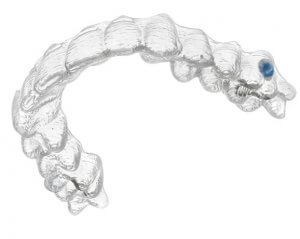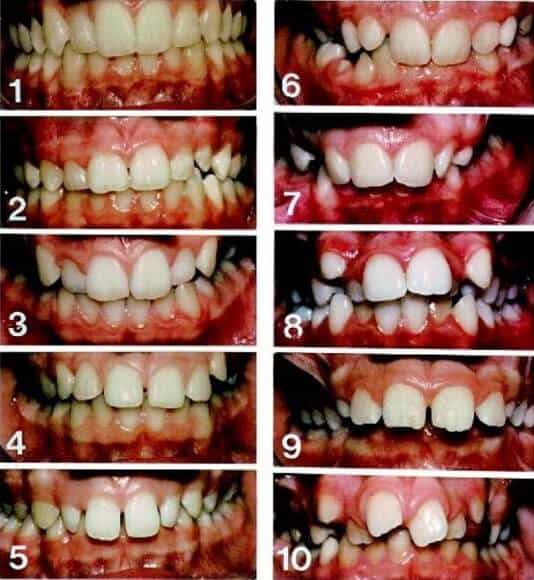Have you been told that your child needs braces, or do you think that they might? You probably have a lot of questions running through your mind, which is why we’ve compiled this comprehensive guide to braces for kids.
There are many types of dental braces available for treating children’s teeth. These include traditional metal braces as well as more modern styles like Invisalign clear aligners.
In this article we discuss the benefits of orthodontics for kids and explain more about the types of children’s braces available in the UK.
But what do braces for kids cost? In the UK, some children can get free braces on the NHS – but only metal ones. The benefit of paying for private treatment is you can opt for clear or invisible braces which your child may feel less self-conscious about.
In This Article
At what age can children have orthodontic braces?

Although braces can straighten teeth at any age, and braces for adults can achieve excellent results, they are usually more effective on children whose bones are still growing and forming. Braces treatment often begins once most adult teeth have erupted. That’s around age 10-14.
However, some children start treatment as early as age 6 or 7 if there is a medical reason to do so. A lot depends on the type of problem they have and how their adult teeth are coming through.
Early treatment can help:
- Guide growth of the jaw bone
- Move teeth into the correct position as they emerge
- Reduce the risk of injury to prominent teeth
- Make space for erupting teeth
- Lower the chances of teeth becoming impacted under gums
- Improve facial aesthetics
But this doesn’t mean that all children need to start treatment early. In some cases it’s better to wait until more adult teeth have come through.
There is no set timeframe for when to take your child in for orthodontic care. In most cases, a child shouldn’t have braces if they haven’t lost most or all of their baby teeth.
Every child has their teeth come in at different times, but most begin to lose their baby teeth at the age of 6 and will continue losing them until they are about 12. Putting your child in braces before they have most of their adult teeth could mean multiple rounds of braces and orthodontic work in the future.
Dr. Travis R. Willey
In some cases, results achieved from braces can be life-changing, extending far beyond straighter teeth. Bristol teenager Lubo Rnic had trouble eating because his protruding teeth prevented his lips from closing properly. It also meant he was the only one in his class at school who couldn’t learn to play the trumpet.
Having completed two and a half years of orthodontic treatment, Lubo’s bite was properly aligned. This not only made it easier for him to eat; his speech also improved and he was finally able to play the trumpet. His transformation earned him the British Orthodontic Society’s 2018 Against The Odds Award and has prompted calls for more research into the wider-reaching benefits of braces.

How long do kids have to wear braces?
This depends entirely on the amount of correction their teeth need. Mild cases may take less than a year whereas the most complex cases (like Lubo above) might require braces for two years or more.
The only way to know for sure is to visit an orthodontist for an assessment. Even then, things may vary from the original treatment plan depending on how your child’s teeth respond to the braces.
When to visit an orthodontist
You should head to the dentist every six months to check your child’s overall oral health as well as the development of their teeth. If the dentist is concerned about your child’s teeth they will refer him or her to an orthodontist – a dentist who specialises in correcting tooth and jaw alignment problems.
Signs that your child may need braces include:

- Losing baby teeth early or late
- Crowded teeth
- Teeth coming through in the wrong position
- Teeth that don’t make contact
- Difficulty eating or biting
- Lips can’t close properly
- They often bite their cheeks
- Thumb sucking or dummy use past age 6
Many orthodontists recommend that children visit by age 7, when their adult teeth have begun appearing. By this stage, any alignment issues should be apparent and the orthodontist can plan their treatment – even if it won’t begin for another few years.
Identifying the need for braces early on means your child can be treated in the most effective way possible. But even if your child is in their teens, it’s not too late to begin treatment.
If you have any concerns, mention them to their dentist or book an appointment directly with an orthodontist.
Will my child need to have teeth extracted before braces?
Sometimes it is necessary to remove one or more teeth to make room for those being straightened to align properly. However, this is not the only solution for crooked teeth. Orthodontic treatment might involve expanding the dental arch slightly to create more space, or it may be possible to file a small amount of enamel from the sides of some teeth so they can align properly.
In fact, only around 25% of children who get fixed braces have to have teeth extracted, according to the NHS Business Services Authority. So if you’re worried about this, don’t let it put you off getting a consultation. In the end, you can trust that the orthodontist knows what will work best for your child.
Types of braces for kids

Metal
Traditional metal braces are by far the most common for children in the UK because they are the only ones funded by the NHS. They are also usually the cheapest option for private treatment.
A bracket is affixed to each tooth and a metal wire joins them all together. By tightening the wire in certain places with regular adjustments, the dentist gradually manipulates teeth into position.
As a parent, you may remember metal braces being enormous and uncomfortable to wear. Fortunately, technology has advanced in the past 25 years or so and brace brackets are much smaller and neater than they used to be.
Kids can have fun choosing the different coloured elastics for their braces each time they visit for an adjustment.
Metal braces offer effective teeth straightening for all kinds of alignment problem, with treatment usually taking 18-24 months.
Children will need special help cleaning their braces and teeth because it’s easy for food and bacteria to get stuck in the brackets. A children’s electric toothbrush with a special orthodontic head can make this process easier, as can interproximal toothbrushes.
In the following video you can view one (not very talkative) young patient’s braces journey, from spacers to fitting to removal:
Invisalign for kids and teens
The Invisalign system offers a completely different way for kids to straighten teeth. Instead of having fixed brackets and wires to adjust, a series of clear, removable aligners guide teeth into position.

This system has some clear advantages for children:
- The aligners are very hard to notice, giving them the name “invisible braces”
- They can be removed for 2-4 hours a day
- Wearers can clean their teeth as normal
- The design allows for new tooth eruption
- A wear indicator on each aligner shows if they are being worn enough
But of course there are some potential downsides, too. Compliance may be an issue, even with the wear indicator, so parents will have to assess whether they think their child has the willpower to wear their aligners as directed.
There is also the issue of eating. You must remove the aligners to eat and drink anything except water, and you have to clean the aligners and your teeth before replacing them. Failure to do this may stain the aligners and teeth, and increase chances of tooth decay.
There are two different treatment options available from Invisalign, depending on the age at which your child needs to begin treatment.
Invisalign First is an early intervention treatment designed for kids aged 6 to 10. It can help to shape the jaw and guide adult teeth as they grow into place. Your Invisalign doctor can let you know whether your child would benefit from this type of treatment.
From around age 11, children may begin regular Invisalign treatment. Invisalign for tweens and teens can be as effective as metal braces, but without being so noticeable. Many kids around this age appreciate being able to avoid taunts of ‘metal mouth’ or ‘brace face’ at school. But they must understand the importance of wearing the aligners all day and cleaning them after eating.
Invisalign aligners work for about 90% of orthodontic cases. If you want to check whether you or your child are eligible, take Invisalign’s free Smile Assessment online now by clicking the button below. It only takes two minutes to fill in some details about your teeth – or your child’s – and you’ll get your results as soon as you submit the form.
In the video below, an Invisalign teenage patient named Margaux explains why she is happy to have invisible braces rather than “train tracks”.
To find out more, discuss whether this is a good option for your child, and get a clear idea of costs, you’ll need to visit an Invisalign provider. They have a large network around the country and you can search for Invisalign providers in your area to see which one is most convenient for you.
Ceramic (clear and tooth-coloured)

These braces function in much the same way as metal ones, but the materials used make them less noticeable. The brackets come in a clear or tooth-coloured material so they blend in better with the teeth. The wire is still usually metal, although it can have a tooth-coloured coating.
The materials used in these braces means they usually cost more than metal, but they could be a good choice for children who are feeling very self-conscious about their orthodontic treatment.
Lingual (Incognito)
Lingual braces use metal brackets and wires but are tucked out of sight behind the teeth, next to the tongue. This positioning makes it very hard to spot them, so they are another good choice for children who are afraid of bullying.
Another benefit is that any staining which occurs as a result of poor oral hygiene will be hidden on the back of the teeth.
However, treatment with lingual braces typically takes longer than with those attached to the front of teeth. They are also generally the most expensive option, and aren’t suitable for children with particularly small teeth.
Wearing a retainer
All these different types of braces have one job: to move teeth into a new position. But the purpose of a retainer is the exact opposite: to stop teeth from moving once treatment is complete.

Your child will probably have to wear a retainer every night at first, and possibly during the day. If they stop wearing it, there is a good chance their teeth will start to move out of alignment again.
Many adults who had braces as a child must continue wearing a retainer for the rest of their lives – at least on a part-time basis – if they want their teeth to stay straight.
There are two main types of removable retainer. One looks much like a clear aligner or mouth guard. The other has an acrylic base and wires that clip around the teeth. Your child will need to take good care of their retainer as replacements can cost £100 or more.
Another way to keep teeth straight is with a fixed retainer. This is just a small wire fixed to the back of the front few teeth to stop them from moving. Ask your dentist about the retainer options for your child after braces.
How much do braces cost for kids in the UK under 18?
The number of appointments and the amount of time spent in the dentist’s chair are the same whatever your age, so don’t expect to get a big discount on the usual adult rate. That said, children’s braces are usually a little cheaper than adults’ braces, simply because less material is required to reach all of their teeth.
Can children get NHS braces in the UK?
Many British children (under age 18) get free orthodontic treatment on the NHS. However, this is only granted if there is a real clinical need for them to have their teeth straightened. Your dentist will assess your child’s teeth to determine whether teeth straightening would be of benefit medically, or purely cosmetically.
What makes braces for kids “medically necessary”? The system used to determine eligibility for NHS braces is called the Index of Orthodontic Treatment Need (IOTN). This index measures certain dental health irregularities and grades them on a scale of 1-5. It considers various factors which can be problematic to oral health.
Grade | Condition of teeth | Eligible for NHS treatment? |
1 | Almost perfect | No |
2 | Slight protrusion of upper front teeth; slight irregularities; no interference with normal function | No |
3 | Protruding upper front teeth, irregularities and open bite all less than 4mm from normal; deep bite with no functional problems | Maybe |
4 | Upper front teeth protruding 6-9mm; lower front teeth protruding more than 3.5mm; irregularities and open bite more than 4mm; deep bite with functional problems; extra or missing teeth | Yes |
5 | Many missing teeth; teeth unable to erupt; severe protrusions; functional difficulties | Yes |
Patients in dental health categories 4 and 5 should automatically get NHS kids’ braces. If your child is placed in category 1 or 2, they are not covered by the NHS for orthodontic work. Those in category 3 will be assessed on a case-by-case basis, according to the aesthetics of their teeth.
“The NHS does recognise that some children need and benefit from orthodontic treatment on the basis of poor aesthetics,” states the British Orthodontic Society.
On this basis, dentists use a visual guide to make a decision about patients placed in category 3. These images were arranged by members of the public in order of attractiveness. Any patient matching image 6 or higher will be considered eligible.

Be aware that dentists don’t make the final decision themselves. They make an assessment and take photos to document the current position of teeth, then send the case to the NHS for approval. Your dentist should be able to give you a good idea of your child’s eligibility, but it’s the ruling from the NHS which stands.
Note that the NHS only offers conventional metal braces to patients. There is often a long waiting list because dentists only receive a certain amount of funding each year. Additionally, NHS patients may only have access to limited appointment times (e.g. between 9 am and 4 pm on weekdays) which can be inconvenient to fit around work or school.
There are a number of reasons why you may pay for your child’s orthodontic work privately instead:
- They were deemed ineligible for NHS braces but you still want to go ahead with the treatment
- The NHS waiting list with your dentist is too long and you want to start treatment sooner
- Your dentist’s NHS appointment times are too inconvenient for you and/or your child
- You would prefer invisible, lingual or ceramic braces instead of metal ones
Some UK dentists offer cheaper braces for kids on the same terms as NHS braces, i.e. with the same restrictions on types and appointment times. This can be a good way to save money on braces for children’s teeth if they have been denied NHS treatment.
How much are private braces for kids in the UK?
The cost of braces for your child if funded privately will depend on a number of factors, including the style you choose and the length and complexity of the treatment required.
The table below gives an idea of what different types of braces for kids cost if both the upper and lower arch need treatment. You’ll need to have a consultation to get a personalised quote for your child.
Remember, you can search for Invisalign providers near you if you’re interested in Invisalign treatment for your child or teenager. Most offer a free initial consultation where you can get a personalised quotation.
Type | Approximate Cost (UK) |
Metal | £1,200 - £3,000 |
Ceramic | £2,000 - £5,500 |
Lingual | £2,000 - £8,000 |
Invisalign | £2,500 - £5,000 |
If these costs seem a little overwhelming, ask about dental payment plans. Many dental clinics have ways for you to spread the cost of treatment, often with 0% interest. Alternatively, a dental loan can help make payments more manageable.
And if you have private dental insurance for your child, it’s worth checking whether your policy will make a contribution towards your kids’ braces costs. Some plans provide orthodontic cover for children, provided the treatment is deemed medically necessary. Even so, most plans only reimburse around 25% of costs – 50% at most – so out-of-pocket costs typically reach thousands of pounds.
How to find a children’s orthodontist
Although any orthodontist can fit braces for children, you may prefer to use one who has experience with younger patients. It’s important your child feels comfortable with their orthodontist so they can ask questions freely and don’t come to dread visits.

One simple way to find a good orthodontist to fit your child’s braces is to ask other parents in your area. Chances are many of them – especially those with older kids – will have some experiences to share.
Your child may even have an idea of which orthodontist they want to see because of stories they have heard from their friends! There is a lot to be said for taking their wishes into account, especially if they are reluctant to get braces in the first place. That said, there may be some other reason why their first choice isn’t possible.
Your choices may be limited by the type of braces you want, since not all orthodontists offer every style and brand. If you have decided on Invisalign, for example, you’ll need to find a specialist Invisalign provider near you. Fortunately, Invisalign have a wide network of providers in the UK – click below to see how many there are in your area:
The location of the dentist’s office is also important. Whichever style of braces you choose, you’ll need to go for regular checkups and adjustments. For minimal disruption to your work day and your child’s school day, choose a dentist or orthodontist close to you.
Then, consider the cost. As mentioned above, some dental clinics have higher prices than others. Some offer special rates for certain types of kids’ braces while others don’t. Shop around a few places if you want to find the best deal on private treatment.
Conclusion
It’s relatively common for children to get braces to straighten their teeth, but as a parent there are many decisions you must make regarding their treatment. The first step is to speak to a dentist or orthodontist to determine whether your child needs orthodontic work.
If your child qualifies for NHS treatment in the UK, they will get metal braces. If not, you will have to pay for private treatment but this gives access to more options, some of which are much less conspicuous.

Invisalign is a popular choice among young patients and their parents since clear aligners are much less noticeable and more comfortable than traditional metal braces. Don’t forget that if you’re considering Invisalign clear aligners, you can begin by taking a free online Smile Assessment to check your child’s eligibility.
Then, search for your nearest provider here and book an appointment to find out more about costs and any other questions you may have.
You’ll need to help your child clean their teeth well while they are wearing braces; using a kids’ fluoride toothpaste will help protect against cavities. There may also be certain foods they have to avoid.
Once treatment is complete, they might need a gentle reminder to wear their retainer as directed. But all this hard work will pay off when they have a straighter smile they feel confident with!
Regardless of the option you choose, we always recommend scheduling a general checkup with your dentist before starting any at-home treatment. It’s important to deal with any untreated cavities or gum disease before wearing aligners and your dentist could assess your overall suitability for the treatment you choose.
British Orthodontic Society. Advice Sheets and Guidelines. Consulted 24th July 2023.
NHS. Braces and Orthodontics. Consulted 24th July 2023.
National Center for Biotechnology Information. Orthodontics in Children and Impact of Malocclusion on Adolescents’ Quality of Life. Consulted 24th July 2023.
British Orthodontic Society. Orthodontics & The NHS. Consulted 24th July 2023.
Dentistry. Trumpeting the power of braces. Consulted 24th July 2023.
Prices stated are indicative only and are based on publicised treatment prices at dental clinics across the UK.





